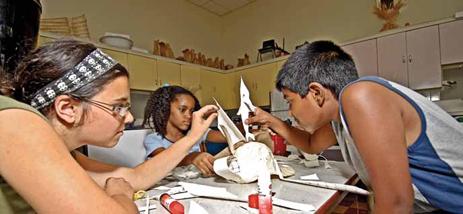
Every Day is Arts Day (Professional Services)
As an elementary teacher, I have witnessed first hand the value of an arts-rich education. Experiences in the arts offer many benefits to our students. The arts provide opportunities to develop creativity and imagination, and to experience joy, beauty, and wonder.The arts also present everyday occasions to enrich the quality of our lives, and to develop creative ways of expressing thoughts, knowledge, and feelings. There is ample evidence that learning in, about, and through the arts contributes to increased engagement in learning in other subject areas, and to the development of students’ self-confidence, social skills, and metacognition.
My experiences in working with children attest to these findings. My students solved problems and developed their ability to express ideas and feelings through role play and working collaboratively on creative projects. I have witnessed the development of self-esteem, discipline, character, co-operative skills, and motivation in my students as they acquired the diverse skills necessary to create a musical theatre production. I have also seen how the arts can foster a greater sense of social responsibility as my students contributed to collaborative works of art, developed an increased awareness and appreciation of diverse cultures, and shared their talents with members of the wider community.
In a newly released literature review entitled Arts Education for the Development of the Whole Child(2012), commissioned by ETFO, Dr. Rena Upitis highlights ways to support and advance arts education for elementary students. The review document examines the effects of taking part in the fine and performing arts—painting, sculpting, writing poetry, playing an instrument, singing, dancing, acting, creating mixed media productions, and film making.
We all have a contribution to make to arts education and, as Arts Education shows, there are many ways to bring the arts into the classroom. Partnerships between generalist teachers, specialist teachers, and art-makers of all kinds can provide rich arts education experiences for elementary students. Ideally, the arts should be both integrated throughout the curriculum and taught as separate curriculum subjects. And the arts should be part of children’s daily school experiences.
Make the arts relevant
Arts activities do not have to be extravagant to be relevant. Do not be afraid to include non traditional arts activities in your classes, such as puppetry, sewing, circus arts, improv, digital photography, or rap. Incorporate repertoire and forms from a variety of contexts, especially those that are important to your students outside of school. Create a class playlist of students’ favourite songs and use the compilation to explore similarities and differences in form, theme, and use of instruments. Write and perform a puppet shaw for students in other classes, or produce books and audio recordings to welcome new students to the school.
Incorporate technology
Web-based and other information technologies can enhance education in the arts. When given the opportunity to use information and communications technology (ICT) in their creative work, elementary students have demonstrated increased motivation, self-regulation, pride, and inventiveness-particularly in situations involving creative expression or composition. There are many freeware programs that allow students to explore sounds and manipulate images or texts (e.g., Audacity, Wordle, Pinterest). These tools can enhance students’ artistic explorations. For example, you could use Audacity, a free audio editor and recorder, to make a radio advertisement, create podcasts, record compositions and class performances, or record soundtracks for animations.
Support generalists with more PD
In order to provide rich daily arts experiences for their students, teachers must directly experience the joy and value of artistic work for themselves—whether by involvement in the arts in their non-teaching time or by enhanced professional arts development and offerings. Substantial professional development is required for generalist elementary teachers in faculties of education, through the ministries of education, and through school boards. Research suggests that the most effective way to develop teacher confidence in the arts is by providing opportunities to teachers for sustained, hands-on art-making. Once teachers see themselves as artists, the transition to bringing arts into the classroom becomes much more fluid.
Hire more specialists
Ontario no longer has arts specialist teachers in every elementary school, in fact, Ontario has the highest proportion of elementary schools where music is taught by generalist classroom teachers with no music qualifications. Three regions of the country have a very large percentage of elementary schools with a specialist music teacher: Quebec (87 percent), the Atlantic Provinces (86 percent), and British Columbia (83 percent).In contrast, 58 percent of Ontario elementary schools rely very strongly on generalist classroom teachers with no music background. Hiring specialist teachers not only enhances the direct instruction to students, it provides opportunities for cross-curricular collaborations among colleagues.
Concluding thoughts
The value of the Arts Education for the Development of the Whole Child review is both broad and profound. It extends an invitation to envision a system of education where the learning that happens in school feels more like the learning that happens in our adult lives, where we take part in informal learning or hobbies with dedication and passion. But the aim of arts education is not only to prepare students for later life. The aim is also to bring moments of joy and beauty into their lives at school. By engaging students wholly in the present moment — in forging relationships, making things, and using their bodies —the arts prepare students for the future by encouraging them to become strong citizens with a finely attuned sense of social responsibility. These outcomes are all possible when the arts are a central part of the education of the whole child.